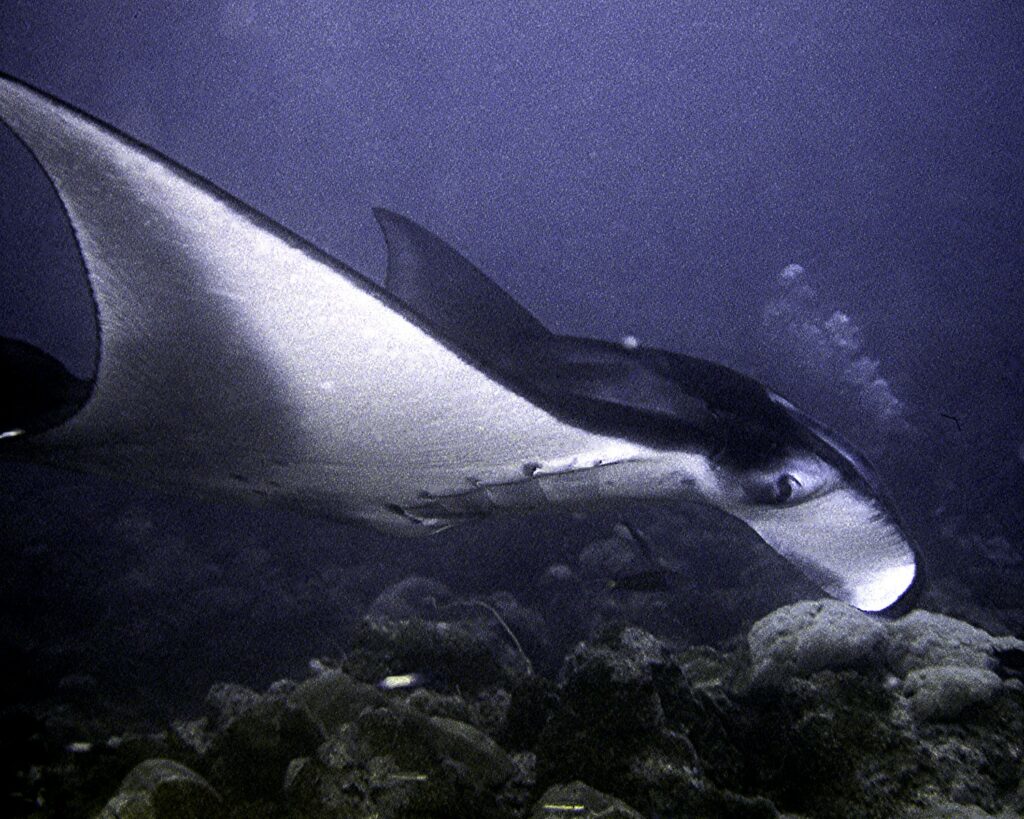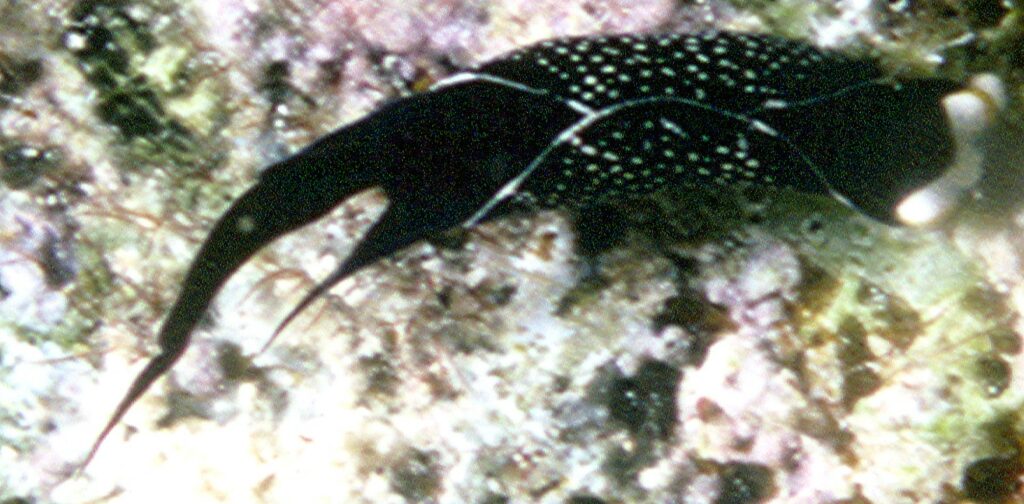Instead of Peter, Peter, Pumpkin-Eater, the phrase about Mantas entered my laughingly limited lexicon in the spring of 1991 when a few folks I knew, and a larger bunch that I didn’t, took a diving trip to Micronesia.
Of course, I went along to look at the invertebrates, but I suspect most of the people were there to see various fish, and for most of those folks, the bigger the fish, the better. On most of the fish-watching trips, a couple of us spent most of our diving time ignoring the fish in the water column for the bottom-dwelling creatures, much to our delight. And, I must say, also much to the delight of the fish watchers as we “bottom grubbers” weren’t in the way.

Some Goniopora photographed on Yap. Goniopora and Manta alfredi both eat plankton, but the coral has better lipstick.
Often these fish watching trips involved going to one of the many sites where, during the proper phase of the tidal cycle, the ebbing tide would drain water from the lagoon across or through the reef. Depending on the current flow, these ebb tide currents can carry all sorts of particulate material from the reef lagoon out through a gap in the reef.
If the topography of the area was “right” the gap in the reef acted like a venturi spraying plankton and larger critters, mostly fish, into the water outside the reef. Once the reef edge was crossed, the water currents dissipated within a few hundred feet of the reef.
Tidal currents are quite predictable and plankton-feeding animals living outside of the reefs knew they could get a free lunch at these ebb tides. Tourist divers would be taken to some of these areas, where they would find a comfortable spot on the bottom, typically in the lee of a large rock, to let the current containing the goodies blow out of the reef past them. There they could watch the “action” as larger fish would come in from off shore to have a snack.
Late one morning, in Yap, our group of divers was ferried to a site some distance offshore over the reef. We could see the reef below us in the water that appeared crystal-clear. After a while, the tide turned and we entered the water, dropped to the bottom, and found our “rocks.” It was evident that many divers had been there before us, as the best observation sites had perching areas worn smooth by previous divers. We settled down on our sites and waited for something to show up.
And we waited. I fiddled with my camera; I focused on a rock. A rock that wouldn’t be a good live rock in an aquarium. Boring…
And I waited.
As we each had only one scuba air cylinder, our loitering time was fairly limited. And as we waited, the other folks looked around for fish. I looked around for invertebrates. I found some coralline algae. Woo woo!!! Boring…
And I waited. Everybody else did, too.
Most people spent their time staring ahead into the now plankton-filled and not-so-crystal clear water. Large forms, shadows really, became visible moving in the distance in the murky water. We were so thrilled. Not! The forms stayed away from us.
And we waited.
Finally, for no good reason, I looked to my left and behind me a bit, instead of straight ahead like everybody else.

A Manta alfredi observing me from about 1.5 m away. This was “my” female, but in this image she is swimming around on her second pass by me. Note the other divers behind her..
I found myself looking into the large right eye of a female Manta Ray (Manta alfredi) holding a position about a meter to my left and about 30 cm (1 ft) above me. Male mantas have claspers on their pelvic fins, females don’t. This one lacked the claspers, so… She… She was staying still with the current flowing over her, so she had to be actively swimming, but no motion was visible anywhere on her body.
I didn’t think it would be prudent to turn and take her picture by flashing my strobes directly into her eyes; somehow the thought of 1) startling a one-ton-plus wild animal that was only a couple of feet from me didn’t seem like the brightest thing to do, and neither did the idea of 2) potentially irritating said animal. One good swat with her huge pectoral fins, and… well, my very active imagination sent me some great graphics showing me either: dead, very unhappy, or very unhappy and dying. None of these seemed like fun at that moment.

“My” female manta swimming over me, on her way out to join her pals in impressing us. They did a good job of impressing!!
Besides she was SO gorgeous, the grace and wonderfully beautiful shape of her body…I was simply enthralled by her beauty and shear ease of movement. So I waited and watched her. We had been told by our dive leaders not to touch the mantas and throughout the dive none of us did so. During “our time together”, probably about five minutes, “my” manta scanned me as completely as I scanned her, maybe more so; the eye watching me was very mobile, and it was obvious she looked me over from front to back and top to bottom, changing her position slightly to be able to scan me as completely as possible from one side.
Mantas have one of the highest brain-to-body-weight ratios of all fishes, as well as a rete mirabile, or a countercurrent heat exchange network of blood vessels, that can keep the brain warmed to about human body temperature, at all times. Some authorities on fish brain structures, consider the mantas as very intelligent animals (R. Glenn Northcutt, pers. comm, 1977). It really looked like she was “thinking” about me; I suspect she was probably laughing at the ungainly and ridiculous creature that dared show up in her realm.

“My” female Manta alfredi swimming by a group of divers in Miil Passage in the reef near Yap Island. The markings on the bottom the rays are distinctive and can be used to identify the animals. Nobody knows how long these animals live, and I think it would interesting to see images of rays taken around Yap in subsequent years to see if she shows up in them.
After a bit I was able to distract my mind from this glorious animal, and got the attention of my human dive partner who was on my right side and still intensely watching the shadows ahead for signs of mantas. I managed to indicate to her that instead of a buddy pair, we were now “a threesome.”
As she looked past me and managed to focus on the manta, she essentially proceeded to become quietly, momentarily, and severely “unglued.” While remaining the good diving partner she was, she held her position while her “excitement” coefficient obviously rose well into the red zone as she was assessing the situation of the moment.
After all, seeing a huge fish apparently on top of one’s diving partner is certainly grounds for extreme—and often immediate—action. However, it became clear that there was no danger and she was able to assure herself of our safety. Only then did she start to enjoy the moment. Her responses as a buddy were absolutely commendable, and I was very favorably, and thankfully, impressed.
About this time, the Manta moved off by slowly and carefully swimming directly over me. Her movements were so graceful and smoothly executed that I could only describe it later as being like “slow teleportation.” After that as she first moved in front of me, and then in front of everybody else, it became apparent we had four or five Mantas swimming among us. They had entered our group from behind our field of view. In later discussions, we assumed they observed and assessed our deployment and situations before slowly and cautiously entering our group. They stayed quite close to us for a while and then swam further afield. They were between 3 and 4 m (9.9 and 13.2 feet) wide.
These animals moved around the group of divers with an ease and grace that was astonishing. By the time I noticed the Manta next to me most of us had less than half our air remaining, and our excitement took its toll on that small volume. In far too short a time, we had to surface.
After we got on our tiny vessel, we were able to watch some of the mantas jumping clear out of the water about 100 m away from us. That was very thrilling. What also was thrilling, but not in the same way, was the realization that we were in a small metal boat on a smooth water surface in the midst of a thunderstorm, with lightening striking the water around us.
As I said: “Thrilling.”
These events happened about 22 years ago, at which time, there were only a few places in the world where it was possible to dive with these wonderful giants. Since then, it has been found that there are definitely two, and perhaps three, species of mantas. Manta alfredi are resident around reefs, while the larger M. birostris are pelagic and tend to be found in the open oceans. Numerous M. alfredi populations around the world are now visited regularly by divers.
Although mantas are preyed upon by large sharks and killer whales, the only real long-term threat they face is from human exploitation, including divers. Too many visitors or visitors doing inappropriate things apparently can cause them to decamp for some new home. However, moving like this means they have to find a new place to feed, and that can result in unwarranted mortality.
Manta rays eat small planktonic organisms, and may eat as much as 13% of their (considerable) body weight every week. The presence of large aggregations of mantas feeding on tiny plankton in waters around coral reefs is one more indication that the plankton populations around those coral reefs are rich and abundant. Reef aquarists often tend to forget just how limiting are our aquariums; for me the memory of the small plankton to large Manta Ray food chain has been a constant reminder of the need for proper foods in every home aquarium.
More importantly, though, for this particular aquarist to come face-to-cephalic-fin with such a huge intelligent fish, it was an awe-inspiring and humbling experience, and made me realize, once again, how much we have to learn about the wonderful parts of our world that are the reefs and the animals on them.
Useful (Generally Recent) References:
Davis, R. E., and R. G. Northcutt, eds. 1983. Fish Neurobiology: Brain Stem and Sense Organs. University of Michigan Press.
Deakos, M. H., J. D. Baker, and L. Bejder. 2011. Characteristics of a manta ray, Manta alfredi, population off Maui, Hawaii, and implications for management. Marine Ecology Progress Series. Vol. 429: 245–260.doi: 10.3354/meps09085
Northcutt, R. Glenn 2008. Forebrain evolution in bony fishes. Brain Research Bulletin. Volume 75, Issues 2–4, 18 March Pages 191–205. http://dx.doi.org/10.1016/j.brainresbull.2007.10.058







Trackbacks/Pingbacks